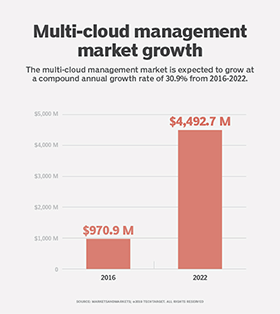
buchachon - Fotolia
Automation drives next wave of multi-cloud management tools
The current cloud landscape indicates a clear need for management tools that can span multiple platforms -- and they'll likely place an emphasis on automation, abstraction and orchestration.
Enterprises adopt multi-cloud strategies so they can select the services that best fit their needs. However, the number of cloud services can easily multiply and add management complexity. The right tool can help -- but enterprises need to choose carefully.
As the market for multi-cloud management tools continues to evolve, it can be difficult to find the right fit. Market consolidation is just one of the many factors enterprises need to consider. Many leading third-party vendors have been acquired -- Microsoft, for example, bought Cloudyn, and CloudHealth Technologies is now a part of VMware. Consolidation will continue in the future, which will likely slow the research and development momentum needed to improve these third-party tools. Organizations need to consider if ownership change at their preferred vendor will affect the product, and, ultimately, their multi-cloud management strategy.
In addition, special-purpose multi-cloud management tools, such as those built for security, cost and performance, won't always be the end game for a lot of enterprises. Orchestration frameworks such as Kubernetes, and the applications platforms built on top of them, can sometimes offer more management consistency for multi-cloud deployments. Products such as OpenShift abstract the underlying infrastructure and treat management as a foundational architectural component, rather than a tool that's bolted on after the fact.
Multi-cloud tools evolve
Multi-cloud management tools have changed a lot in the last several years. These tools were once used as brokerage services or abstraction layers that boiled public clouds down to the lowest common denominator. But, as organizations move to higher-level cloud services and agile development practices, these tools are now more about enabling automation and governance.
The next generation of multi-cloud management tools and approaches focus on three features:
Automation
Ops-focused tools deal with cloud services in terms of individual components that they need to track. They do so by automating the use of the services by "what" and "who" to assist with security. For example, they might track which developers are using which specific services, for what purpose and when. The tool logs all service usage to enable automated updates, change management and configuration management, which are fundamental to development and operations.
Abstraction
This approach deploys services on top of the native cloud services and creates a single way to look at storage, compute, security and other resources across different cloud platforms. The idea is to provide a common way to look at storage, compute and other related IT concepts in order to bring the back end down to the native API level. This technology reduces human intervention, which, in turn, limits mistakes and speeds up management.
However, keep in mind that if you hide more native services under abstraction services, you dilute the value of those services and are left with a least-common-denominator approach. For example, if you use a common storage concept and just use a service to store, retrieve and delete, you may miss out on native services, such as rollbacks, that are limited to a single provider.
Container orchestration
Container orchestration, made popular by technologies like Kubernetes, enables native cloud services to be managed as containers. Enterprises can cluster and manage them with container orchestration tools.

They can pool resources to scale and manage them as single clusters or groups. Developers and operations teams have more control over their workloads because they can deal with containers as micro or macro concepts.
This approach is developer- and ops-focused and can provide portability between clouds. Enterprises have rapidly moved to these tools because containers are standard and not married to any technology stack. However, not all applications are easily placed in containers. For example, COBOL and file-based database systems don't have good deployment analogs for containers. This requires a redevelopment effort, as well as a redeployment effort.
What's next for multi-cloud management tools? The current market landscape indicates there's a clear need for multi-cloud management. Most enterprises won't be able to resist the use of more than one cloud, so there will need to be tools to enable enterprises to do so at scale.
Watch for vendors to focus on machine learning to support those efforts. Companies such as CA Technologies and Densify are already building AI into their services, and expect it to be an area of focus for even more companies in the future as they seek to help enterprises manage their workloads across multiple environments.






